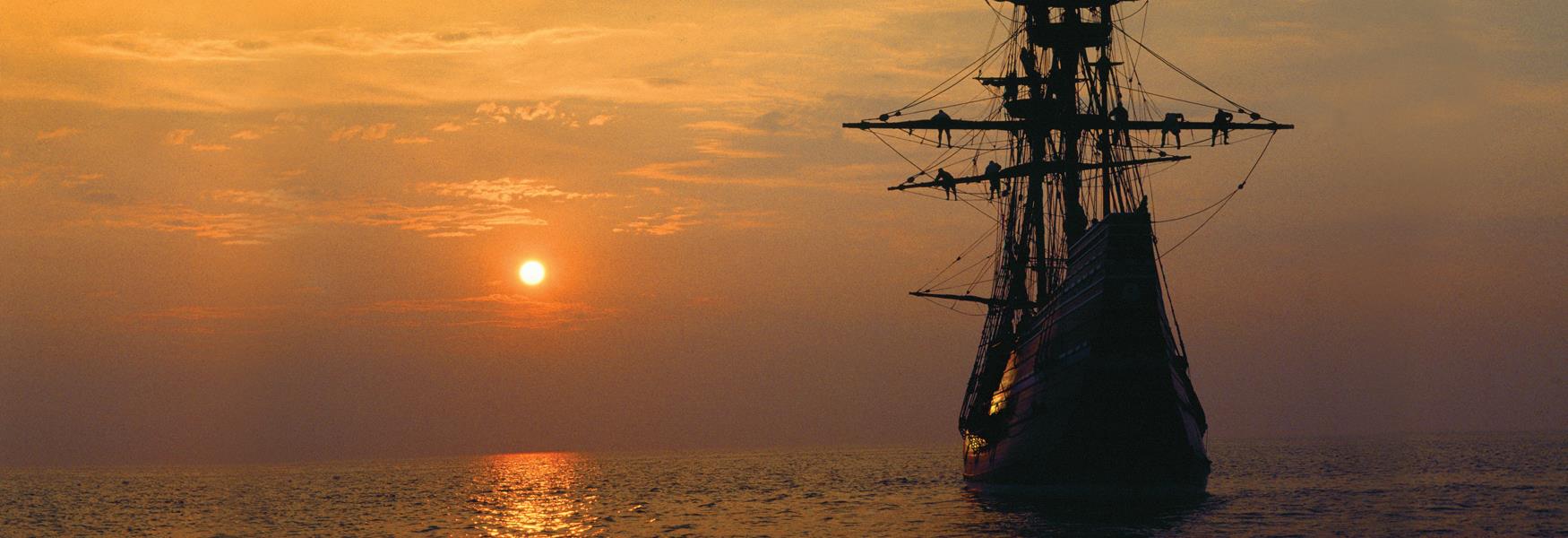The Mayflower Story
On 16 September 1620, the Mayflower sailed from Plymouth UK with just 102 passengers and crew on board with what William Bradford, an English Separatist who became the American Plymouth Colony Governor, called “a prosperous wind.”
The Ship
The Mayflower was a three-masted ship, most likely between 90 and 110 feet long that transported mostly English Puritans and Separatists, collectively known today as the Pilgrims, from a site near the Mayflower Steps in Plymouth, England, to America in 1620.
The Journey
The Mayflower embarked about 65 passengers in London, at its homeport of Rotherhithe on the Thames in the middle of July 1620. She then proceeded down the Thames into the English Channel and on to the south coast to anchor at Southampton. There the Mayflower waited for seven days for a rendezvous with the Speedwell, another ship which was coming with Separatist members from Leiden, Holland. On about 15 August, the two ships set sail, however the Speedwell sprang a leak shortly after and the ships had to put into Dartmouth for repairs.
Once these repairs were made the two ships once again set sail. However, once past Land’s End the Speedwell once again started to leak and both ships were forced to pull in to Plymouth. The Mayflower's provisions, already quite low when departing Southampton, became lower by delays of more than of a month. The passengers, having been aboard ship for all this time, were quite worn out by then and in no condition for a very taxing lengthy Atlantic journey cooped up in cramped spaces in a small ship. The Speedwell was abandoned and on the 16 September 1620 the Mayflower sailed from Plymouth arriving at Cape Cod on 19 November 1620, after a 66 day voyage. On its voyage to the New World, there were two deaths, but this was only a precursor of what happened after their arrival in Cape Cod, where almost half the company would die in the first winter.
On 19 November 1620, they sighted land, which is the present-day Cape Cod. After several days of trying to sail south to their planned destination of the Colony of Virginia, where they had already obtained permission from the Company of Merchant Adventurers to settle. Strong winter seas forced them to return to the harbour at Cape Cod hook, well north of the intended area where they anchored on 21 November. They finally landed in the colony of Plimoth in the State of Massachusetts, USA on 21 December 1620.
When the Pilgrims left England, they obtained permission from the King to settle on land further to the south near the mouth of the Hudson River (in present-day New York). Because they chose to remain where they landed in New England, they needed a new permission (called a patent) to settle there. To establish legal order and to quell increasing strife within the ranks, the settlers wrote and signed the ‘Mayflower Compact’ after the ship dropped anchor at the tip of Cape Cod on 21 November, in what is now Provincetown Harbor. Each year one of the biggest celebrations in the USA – Thanksgiving Day – commemorates the Pilgrims’ first harvest.
National Trail - Exploring Plymouth
Take a look at our Mayflower400 National Trail film and discover all the beautiful destinations in the UK and Leiden linked to the Pilgrims' epic voyage:


 to add an item to your Itinerary basket.
to add an item to your Itinerary basket.








Tweet, Follow & Share